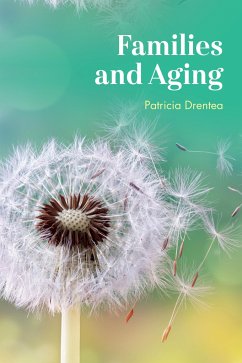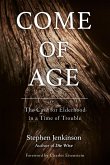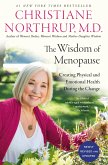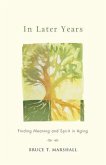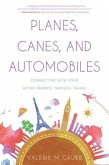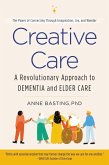Drentea, Patricia, University of Alabama, Birmingham
Families and Aging
Drentea, Patricia, University of Alabama, Birmingham
Families and Aging
- Gebundenes Buch
- Merkliste
- Auf die Merkliste
- Bewerten Bewerten
- Teilen
- Produkt teilen
- Produkterinnerung
- Produkterinnerung
Patricia Drenteaâ s Families and Aging examines how the changing lifestyles and diversity of families of Americans will affect aging in later life. It explores the life course transitions that occur as individuals and families age, and considers how these social trends affect lives and society as a whole.
Andere Kunden interessierten sich auch für
![Come of Age: The Case for Elderhood in a Time of Trouble Come of Age: The Case for Elderhood in a Time of Trouble]() Stephen JenkinsonCome of Age: The Case for Elderhood in a Time of Trouble21,99 €
Stephen JenkinsonCome of Age: The Case for Elderhood in a Time of Trouble21,99 €![The Wisdom of Menopause (4th Edition): Creating Physical and Emotional Health During the Change The Wisdom of Menopause (4th Edition): Creating Physical and Emotional Health During the Change]() M.D., Christiane Northrup,The Wisdom of Menopause (4th Edition): Creating Physical and Emotional Health During the Change27,99 €
M.D., Christiane Northrup,The Wisdom of Menopause (4th Edition): Creating Physical and Emotional Health During the Change27,99 €![In Later Years: Finding Meaning and Spirit in Aging In Later Years: Finding Meaning and Spirit in Aging]() Bruce T. Marshall (Bruce T. Marshall)In Later Years: Finding Meaning and Spirit in Aging16,99 €
Bruce T. Marshall (Bruce T. Marshall)In Later Years: Finding Meaning and Spirit in Aging16,99 €![Planes, Canes, and Automobiles: Connecting with Your Aging Parents Through Travel Planes, Canes, and Automobiles: Connecting with Your Aging Parents Through Travel]() Valerie M. GrubbPlanes, Canes, and Automobiles: Connecting with Your Aging Parents Through Travel16,99 €
Valerie M. GrubbPlanes, Canes, and Automobiles: Connecting with Your Aging Parents Through Travel16,99 €![The Art and Science of Connection The Art and Science of Connection]() Kasley KillamThe Art and Science of Connection17,99 €
Kasley KillamThe Art and Science of Connection17,99 €![Creative Care Creative Care]() Anne BastingCreative Care16,99 €
Anne BastingCreative Care16,99 €![My Life as a Villainess My Life as a Villainess]() Laura LippmanMy Life as a Villainess18,99 €
Laura LippmanMy Life as a Villainess18,99 €-
-
-
Patricia Drenteaâ s Families and Aging examines how the changing lifestyles and diversity of families of Americans will affect aging in later life. It explores the life course transitions that occur as individuals and families age, and considers how these social trends affect lives and society as a whole.
Hinweis: Dieser Artikel kann nur an eine deutsche Lieferadresse ausgeliefert werden.
Hinweis: Dieser Artikel kann nur an eine deutsche Lieferadresse ausgeliefert werden.
Produktdetails
- Produktdetails
- Verlag: Rowman & Littlefield
- Seitenzahl: 208
- Erscheinungstermin: 5. November 2018
- Englisch
- Abmessung: 257mm x 180mm x 15mm
- Gewicht: 532g
- ISBN-13: 9781538104330
- ISBN-10: 1538104334
- Artikelnr.: 53215782
- Herstellerkennzeichnung
- Libri GmbH
- Europaallee 1
- 36244 Bad Hersfeld
- gpsr@libri.de
- Verlag: Rowman & Littlefield
- Seitenzahl: 208
- Erscheinungstermin: 5. November 2018
- Englisch
- Abmessung: 257mm x 180mm x 15mm
- Gewicht: 532g
- ISBN-13: 9781538104330
- ISBN-10: 1538104334
- Artikelnr.: 53215782
- Herstellerkennzeichnung
- Libri GmbH
- Europaallee 1
- 36244 Bad Hersfeld
- gpsr@libri.de
By Patricia Drentea
Acknowledgements Preface 1.Introduction to Aging Families 2.Data and
Methods 3.Structure of the Chapters 4.Organization of the book Chapter 1.
Introduction to Aging Families Provides an overview of major social changes
in aging Vignette-Older woman who is more what the face of the future will
be than what is today Chapter Objectives 1.Increase of older adult
population The Baby Boomers Life Expectancy in the United States The past,
present, and future Box-How to become a centenarian 2.Changes in world
population Box about future world population 3.Box-What is a family?
4.Facts about families Diverse Family Forms More options Trends in the
Aging Family Longer Life Span More Needs for Caregiving 5.Changes In
Diversity-Race And Ethnicity Current Versus Future Population in the U.S.
The Changing Landscape of the Population 6.Changes in socioeconomic status
Increased Standard of Living for Most Continued Inequality 7.Changes in
health Healthier than before Chronic illness Communicable Illness Health
Disparities 8.Summary 9.Critical Thinking Questions Chapter 2. Diversity in
American Society The story is one of diversity in the 21st century. Begins
with postmodern theory about diversity of society etc. Diversity is about
changing landscape of more common and visible types of families. Chapter
Objectives 1.Theory of postmodern complex life Increasing diversity of
families 2.Modern versus traditional 3.Increasing diversity of realities
Major trends in intimate relationships: the impact on aging families
Divorce Remarriage and stepfamilies Single parenting Cohabitation
Singlehood Childlessness Box-Childfree by Choice DINKS LGBTQ Families
Families of Choice Biracial and Multiracial/Multiethnic Families
Religiosity 4.Traditional Pulls 5.Summary 6.Critical Thinking Questions
Chapter 3- Changing Gender Roles: Effects on Aging Experience Women now are
coming of age during time of more options, different family patterns, more
work, more likely to have different expectations of men. For many older
women, they came of age in the 1970s, during the women's revolution, after
the civil rights movement, and during a time when the world was opening up
to them. Chapter Objectives 1.Feminist Theory Six Propositions 2.Changes in
Gendered Lives Over Time Spouse Parenting Worker 3.Gender, Dating and
Sexuality Dating Sexuality in Later Life STIs and Aging 4.Widowhood
5.Social Roles, Sex Roles, and Mental Health 6.Summary 7.Critical Thinking
Questions Chapter 4. Parenthood Later In Life Provides an overview of
having children in later life, and issues relevant to all parents as they
get older. Chapter Objectives 1.The life course paradigm increasing
heterogeneity 2.Increasing Age at First Birth 3.Reproductive Medicine and
Technology Advanced maternal age-women 35 and over chart- Risks and
Benefits of Women Having Children Over 35 Down Syndrome Table 5.1 Incidence
of Down syndrome by age of mother Box-World's Oldest Moms Twins and
multiples 4.Older Parents and Psychosocial Implications Boomerang children
5.Intergenerational linkages The Sandwich Generation 6.Transfers
7.Dispossession 8.Summary 9.Critical Thinking Questions Chapter 5. Work and
Retirement The story of how people interact with their cohort and the
social structure. Each cohort is different because it is had different
experiences. New cohorts will be different from before because women have
worked, more educated population, rise of technology. How economic and
family issues affect work careers, retirement etc. Chapter Objectives
1.Theory-age stratification 2.Changes in the dependency ratio 3.Changes in
estimated work life Estimated Work Life Work in later life Work and Family
in Later Life Retirement Duration and Reasons for Increase in retirement
BOX-Financial Planning for Retirement Phased retirement Savings in later
life The great recession and the effects on working Debt Unemployment
4.Summary 5.Critical Thinking Questions Chapter 6. Activities in Later Life
The story to tell is about activities in later life, work, and retirement
with trends in both early retirement and working later in life. Activities
may center around things people liked to do their whole life, but also when
an extra 30 years is appended to a life. One activity is increasing
grandparenting. Discussion of where seniors live. Chapter Objectives
1.Theory-activity theory and continuity theory 2.Activities in later life
More leisure time and opportunities Consumerism: America's favorite
hobby-shopping? The other side 3.Travel and adult education programs
4.Grandparenting extended time grandparenting, quality and quantity
grandparenting as an identity styles of grandparenting Box-an example of
custodial living Divorce/reconstituted families and grandparents 5.Moving,
activities and families in later life 6.Technology Connectivity and social
media 7.Summary 8.Critical Thinking Questions Chapter 7. Health and
Caregiving Story is that we are living longer, and generally healthier.
There's been an expansion of morbidity, but also a compression. We can be
healthier longer, but have new things to worry about such as wear and tear
of joints, being kept alive artificially too long etc. Increasing need for
caregiving. Chapter Objectives 1.Theory-cumulative advantage and
disadvantage 2.Improved health overall, vitality and aging well Health
Activities of daily living D. Expansion versus compression of morbidity E.
Socioeconomic status and health F. Caregiving caregiving measures men's
caregiving increase in male caregiving 10.Need for social support
11.Alzheimer's disease-a special case in caregiving and social support
Box-warning signs of Alzheimer's Disease 12.Living arrangements
13.Assistive technology 14.Assisted Care, Advanced Care Planning, and
End-of-Life Decisions 15.Summary 16.Critical Thinking Questions Chapter 8.
Conclusion Chapter Objectives 1.Introduction 2.Societal Changes 3.Dominant
Social Changes: Future Directions for Society 1.Technology and
Communication 2.Globalization and families 3.Intercultural marriage and
increasing heterogeneity of families 4.Increased distance from families
5.Increased choices for living arrangements 6.More social roles for later
life 4.Elder Mistreatment 5.Summary 6.Critical Thinking Questions GLOSSARY
REFERENCES INDEX
Methods 3.Structure of the Chapters 4.Organization of the book Chapter 1.
Introduction to Aging Families Provides an overview of major social changes
in aging Vignette-Older woman who is more what the face of the future will
be than what is today Chapter Objectives 1.Increase of older adult
population The Baby Boomers Life Expectancy in the United States The past,
present, and future Box-How to become a centenarian 2.Changes in world
population Box about future world population 3.Box-What is a family?
4.Facts about families Diverse Family Forms More options Trends in the
Aging Family Longer Life Span More Needs for Caregiving 5.Changes In
Diversity-Race And Ethnicity Current Versus Future Population in the U.S.
The Changing Landscape of the Population 6.Changes in socioeconomic status
Increased Standard of Living for Most Continued Inequality 7.Changes in
health Healthier than before Chronic illness Communicable Illness Health
Disparities 8.Summary 9.Critical Thinking Questions Chapter 2. Diversity in
American Society The story is one of diversity in the 21st century. Begins
with postmodern theory about diversity of society etc. Diversity is about
changing landscape of more common and visible types of families. Chapter
Objectives 1.Theory of postmodern complex life Increasing diversity of
families 2.Modern versus traditional 3.Increasing diversity of realities
Major trends in intimate relationships: the impact on aging families
Divorce Remarriage and stepfamilies Single parenting Cohabitation
Singlehood Childlessness Box-Childfree by Choice DINKS LGBTQ Families
Families of Choice Biracial and Multiracial/Multiethnic Families
Religiosity 4.Traditional Pulls 5.Summary 6.Critical Thinking Questions
Chapter 3- Changing Gender Roles: Effects on Aging Experience Women now are
coming of age during time of more options, different family patterns, more
work, more likely to have different expectations of men. For many older
women, they came of age in the 1970s, during the women's revolution, after
the civil rights movement, and during a time when the world was opening up
to them. Chapter Objectives 1.Feminist Theory Six Propositions 2.Changes in
Gendered Lives Over Time Spouse Parenting Worker 3.Gender, Dating and
Sexuality Dating Sexuality in Later Life STIs and Aging 4.Widowhood
5.Social Roles, Sex Roles, and Mental Health 6.Summary 7.Critical Thinking
Questions Chapter 4. Parenthood Later In Life Provides an overview of
having children in later life, and issues relevant to all parents as they
get older. Chapter Objectives 1.The life course paradigm increasing
heterogeneity 2.Increasing Age at First Birth 3.Reproductive Medicine and
Technology Advanced maternal age-women 35 and over chart- Risks and
Benefits of Women Having Children Over 35 Down Syndrome Table 5.1 Incidence
of Down syndrome by age of mother Box-World's Oldest Moms Twins and
multiples 4.Older Parents and Psychosocial Implications Boomerang children
5.Intergenerational linkages The Sandwich Generation 6.Transfers
7.Dispossession 8.Summary 9.Critical Thinking Questions Chapter 5. Work and
Retirement The story of how people interact with their cohort and the
social structure. Each cohort is different because it is had different
experiences. New cohorts will be different from before because women have
worked, more educated population, rise of technology. How economic and
family issues affect work careers, retirement etc. Chapter Objectives
1.Theory-age stratification 2.Changes in the dependency ratio 3.Changes in
estimated work life Estimated Work Life Work in later life Work and Family
in Later Life Retirement Duration and Reasons for Increase in retirement
BOX-Financial Planning for Retirement Phased retirement Savings in later
life The great recession and the effects on working Debt Unemployment
4.Summary 5.Critical Thinking Questions Chapter 6. Activities in Later Life
The story to tell is about activities in later life, work, and retirement
with trends in both early retirement and working later in life. Activities
may center around things people liked to do their whole life, but also when
an extra 30 years is appended to a life. One activity is increasing
grandparenting. Discussion of where seniors live. Chapter Objectives
1.Theory-activity theory and continuity theory 2.Activities in later life
More leisure time and opportunities Consumerism: America's favorite
hobby-shopping? The other side 3.Travel and adult education programs
4.Grandparenting extended time grandparenting, quality and quantity
grandparenting as an identity styles of grandparenting Box-an example of
custodial living Divorce/reconstituted families and grandparents 5.Moving,
activities and families in later life 6.Technology Connectivity and social
media 7.Summary 8.Critical Thinking Questions Chapter 7. Health and
Caregiving Story is that we are living longer, and generally healthier.
There's been an expansion of morbidity, but also a compression. We can be
healthier longer, but have new things to worry about such as wear and tear
of joints, being kept alive artificially too long etc. Increasing need for
caregiving. Chapter Objectives 1.Theory-cumulative advantage and
disadvantage 2.Improved health overall, vitality and aging well Health
Activities of daily living D. Expansion versus compression of morbidity E.
Socioeconomic status and health F. Caregiving caregiving measures men's
caregiving increase in male caregiving 10.Need for social support
11.Alzheimer's disease-a special case in caregiving and social support
Box-warning signs of Alzheimer's Disease 12.Living arrangements
13.Assistive technology 14.Assisted Care, Advanced Care Planning, and
End-of-Life Decisions 15.Summary 16.Critical Thinking Questions Chapter 8.
Conclusion Chapter Objectives 1.Introduction 2.Societal Changes 3.Dominant
Social Changes: Future Directions for Society 1.Technology and
Communication 2.Globalization and families 3.Intercultural marriage and
increasing heterogeneity of families 4.Increased distance from families
5.Increased choices for living arrangements 6.More social roles for later
life 4.Elder Mistreatment 5.Summary 6.Critical Thinking Questions GLOSSARY
REFERENCES INDEX
Acknowledgements Preface 1.Introduction to Aging Families 2.Data and
Methods 3.Structure of the Chapters 4.Organization of the book Chapter 1.
Introduction to Aging Families Provides an overview of major social changes
in aging Vignette-Older woman who is more what the face of the future will
be than what is today Chapter Objectives 1.Increase of older adult
population The Baby Boomers Life Expectancy in the United States The past,
present, and future Box-How to become a centenarian 2.Changes in world
population Box about future world population 3.Box-What is a family?
4.Facts about families Diverse Family Forms More options Trends in the
Aging Family Longer Life Span More Needs for Caregiving 5.Changes In
Diversity-Race And Ethnicity Current Versus Future Population in the U.S.
The Changing Landscape of the Population 6.Changes in socioeconomic status
Increased Standard of Living for Most Continued Inequality 7.Changes in
health Healthier than before Chronic illness Communicable Illness Health
Disparities 8.Summary 9.Critical Thinking Questions Chapter 2. Diversity in
American Society The story is one of diversity in the 21st century. Begins
with postmodern theory about diversity of society etc. Diversity is about
changing landscape of more common and visible types of families. Chapter
Objectives 1.Theory of postmodern complex life Increasing diversity of
families 2.Modern versus traditional 3.Increasing diversity of realities
Major trends in intimate relationships: the impact on aging families
Divorce Remarriage and stepfamilies Single parenting Cohabitation
Singlehood Childlessness Box-Childfree by Choice DINKS LGBTQ Families
Families of Choice Biracial and Multiracial/Multiethnic Families
Religiosity 4.Traditional Pulls 5.Summary 6.Critical Thinking Questions
Chapter 3- Changing Gender Roles: Effects on Aging Experience Women now are
coming of age during time of more options, different family patterns, more
work, more likely to have different expectations of men. For many older
women, they came of age in the 1970s, during the women's revolution, after
the civil rights movement, and during a time when the world was opening up
to them. Chapter Objectives 1.Feminist Theory Six Propositions 2.Changes in
Gendered Lives Over Time Spouse Parenting Worker 3.Gender, Dating and
Sexuality Dating Sexuality in Later Life STIs and Aging 4.Widowhood
5.Social Roles, Sex Roles, and Mental Health 6.Summary 7.Critical Thinking
Questions Chapter 4. Parenthood Later In Life Provides an overview of
having children in later life, and issues relevant to all parents as they
get older. Chapter Objectives 1.The life course paradigm increasing
heterogeneity 2.Increasing Age at First Birth 3.Reproductive Medicine and
Technology Advanced maternal age-women 35 and over chart- Risks and
Benefits of Women Having Children Over 35 Down Syndrome Table 5.1 Incidence
of Down syndrome by age of mother Box-World's Oldest Moms Twins and
multiples 4.Older Parents and Psychosocial Implications Boomerang children
5.Intergenerational linkages The Sandwich Generation 6.Transfers
7.Dispossession 8.Summary 9.Critical Thinking Questions Chapter 5. Work and
Retirement The story of how people interact with their cohort and the
social structure. Each cohort is different because it is had different
experiences. New cohorts will be different from before because women have
worked, more educated population, rise of technology. How economic and
family issues affect work careers, retirement etc. Chapter Objectives
1.Theory-age stratification 2.Changes in the dependency ratio 3.Changes in
estimated work life Estimated Work Life Work in later life Work and Family
in Later Life Retirement Duration and Reasons for Increase in retirement
BOX-Financial Planning for Retirement Phased retirement Savings in later
life The great recession and the effects on working Debt Unemployment
4.Summary 5.Critical Thinking Questions Chapter 6. Activities in Later Life
The story to tell is about activities in later life, work, and retirement
with trends in both early retirement and working later in life. Activities
may center around things people liked to do their whole life, but also when
an extra 30 years is appended to a life. One activity is increasing
grandparenting. Discussion of where seniors live. Chapter Objectives
1.Theory-activity theory and continuity theory 2.Activities in later life
More leisure time and opportunities Consumerism: America's favorite
hobby-shopping? The other side 3.Travel and adult education programs
4.Grandparenting extended time grandparenting, quality and quantity
grandparenting as an identity styles of grandparenting Box-an example of
custodial living Divorce/reconstituted families and grandparents 5.Moving,
activities and families in later life 6.Technology Connectivity and social
media 7.Summary 8.Critical Thinking Questions Chapter 7. Health and
Caregiving Story is that we are living longer, and generally healthier.
There's been an expansion of morbidity, but also a compression. We can be
healthier longer, but have new things to worry about such as wear and tear
of joints, being kept alive artificially too long etc. Increasing need for
caregiving. Chapter Objectives 1.Theory-cumulative advantage and
disadvantage 2.Improved health overall, vitality and aging well Health
Activities of daily living D. Expansion versus compression of morbidity E.
Socioeconomic status and health F. Caregiving caregiving measures men's
caregiving increase in male caregiving 10.Need for social support
11.Alzheimer's disease-a special case in caregiving and social support
Box-warning signs of Alzheimer's Disease 12.Living arrangements
13.Assistive technology 14.Assisted Care, Advanced Care Planning, and
End-of-Life Decisions 15.Summary 16.Critical Thinking Questions Chapter 8.
Conclusion Chapter Objectives 1.Introduction 2.Societal Changes 3.Dominant
Social Changes: Future Directions for Society 1.Technology and
Communication 2.Globalization and families 3.Intercultural marriage and
increasing heterogeneity of families 4.Increased distance from families
5.Increased choices for living arrangements 6.More social roles for later
life 4.Elder Mistreatment 5.Summary 6.Critical Thinking Questions GLOSSARY
REFERENCES INDEX
Methods 3.Structure of the Chapters 4.Organization of the book Chapter 1.
Introduction to Aging Families Provides an overview of major social changes
in aging Vignette-Older woman who is more what the face of the future will
be than what is today Chapter Objectives 1.Increase of older adult
population The Baby Boomers Life Expectancy in the United States The past,
present, and future Box-How to become a centenarian 2.Changes in world
population Box about future world population 3.Box-What is a family?
4.Facts about families Diverse Family Forms More options Trends in the
Aging Family Longer Life Span More Needs for Caregiving 5.Changes In
Diversity-Race And Ethnicity Current Versus Future Population in the U.S.
The Changing Landscape of the Population 6.Changes in socioeconomic status
Increased Standard of Living for Most Continued Inequality 7.Changes in
health Healthier than before Chronic illness Communicable Illness Health
Disparities 8.Summary 9.Critical Thinking Questions Chapter 2. Diversity in
American Society The story is one of diversity in the 21st century. Begins
with postmodern theory about diversity of society etc. Diversity is about
changing landscape of more common and visible types of families. Chapter
Objectives 1.Theory of postmodern complex life Increasing diversity of
families 2.Modern versus traditional 3.Increasing diversity of realities
Major trends in intimate relationships: the impact on aging families
Divorce Remarriage and stepfamilies Single parenting Cohabitation
Singlehood Childlessness Box-Childfree by Choice DINKS LGBTQ Families
Families of Choice Biracial and Multiracial/Multiethnic Families
Religiosity 4.Traditional Pulls 5.Summary 6.Critical Thinking Questions
Chapter 3- Changing Gender Roles: Effects on Aging Experience Women now are
coming of age during time of more options, different family patterns, more
work, more likely to have different expectations of men. For many older
women, they came of age in the 1970s, during the women's revolution, after
the civil rights movement, and during a time when the world was opening up
to them. Chapter Objectives 1.Feminist Theory Six Propositions 2.Changes in
Gendered Lives Over Time Spouse Parenting Worker 3.Gender, Dating and
Sexuality Dating Sexuality in Later Life STIs and Aging 4.Widowhood
5.Social Roles, Sex Roles, and Mental Health 6.Summary 7.Critical Thinking
Questions Chapter 4. Parenthood Later In Life Provides an overview of
having children in later life, and issues relevant to all parents as they
get older. Chapter Objectives 1.The life course paradigm increasing
heterogeneity 2.Increasing Age at First Birth 3.Reproductive Medicine and
Technology Advanced maternal age-women 35 and over chart- Risks and
Benefits of Women Having Children Over 35 Down Syndrome Table 5.1 Incidence
of Down syndrome by age of mother Box-World's Oldest Moms Twins and
multiples 4.Older Parents and Psychosocial Implications Boomerang children
5.Intergenerational linkages The Sandwich Generation 6.Transfers
7.Dispossession 8.Summary 9.Critical Thinking Questions Chapter 5. Work and
Retirement The story of how people interact with their cohort and the
social structure. Each cohort is different because it is had different
experiences. New cohorts will be different from before because women have
worked, more educated population, rise of technology. How economic and
family issues affect work careers, retirement etc. Chapter Objectives
1.Theory-age stratification 2.Changes in the dependency ratio 3.Changes in
estimated work life Estimated Work Life Work in later life Work and Family
in Later Life Retirement Duration and Reasons for Increase in retirement
BOX-Financial Planning for Retirement Phased retirement Savings in later
life The great recession and the effects on working Debt Unemployment
4.Summary 5.Critical Thinking Questions Chapter 6. Activities in Later Life
The story to tell is about activities in later life, work, and retirement
with trends in both early retirement and working later in life. Activities
may center around things people liked to do their whole life, but also when
an extra 30 years is appended to a life. One activity is increasing
grandparenting. Discussion of where seniors live. Chapter Objectives
1.Theory-activity theory and continuity theory 2.Activities in later life
More leisure time and opportunities Consumerism: America's favorite
hobby-shopping? The other side 3.Travel and adult education programs
4.Grandparenting extended time grandparenting, quality and quantity
grandparenting as an identity styles of grandparenting Box-an example of
custodial living Divorce/reconstituted families and grandparents 5.Moving,
activities and families in later life 6.Technology Connectivity and social
media 7.Summary 8.Critical Thinking Questions Chapter 7. Health and
Caregiving Story is that we are living longer, and generally healthier.
There's been an expansion of morbidity, but also a compression. We can be
healthier longer, but have new things to worry about such as wear and tear
of joints, being kept alive artificially too long etc. Increasing need for
caregiving. Chapter Objectives 1.Theory-cumulative advantage and
disadvantage 2.Improved health overall, vitality and aging well Health
Activities of daily living D. Expansion versus compression of morbidity E.
Socioeconomic status and health F. Caregiving caregiving measures men's
caregiving increase in male caregiving 10.Need for social support
11.Alzheimer's disease-a special case in caregiving and social support
Box-warning signs of Alzheimer's Disease 12.Living arrangements
13.Assistive technology 14.Assisted Care, Advanced Care Planning, and
End-of-Life Decisions 15.Summary 16.Critical Thinking Questions Chapter 8.
Conclusion Chapter Objectives 1.Introduction 2.Societal Changes 3.Dominant
Social Changes: Future Directions for Society 1.Technology and
Communication 2.Globalization and families 3.Intercultural marriage and
increasing heterogeneity of families 4.Increased distance from families
5.Increased choices for living arrangements 6.More social roles for later
life 4.Elder Mistreatment 5.Summary 6.Critical Thinking Questions GLOSSARY
REFERENCES INDEX

